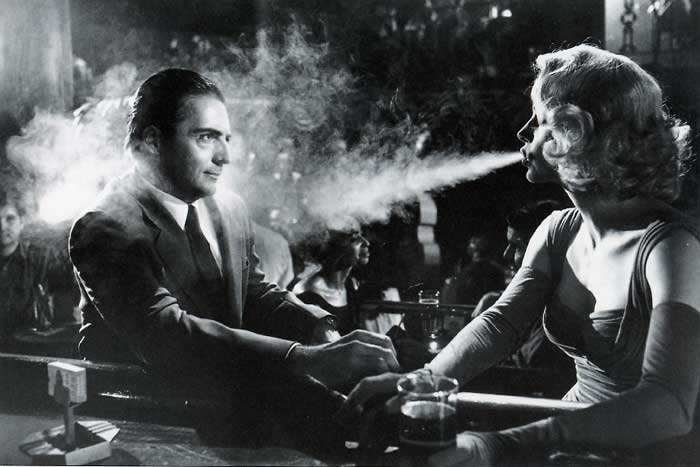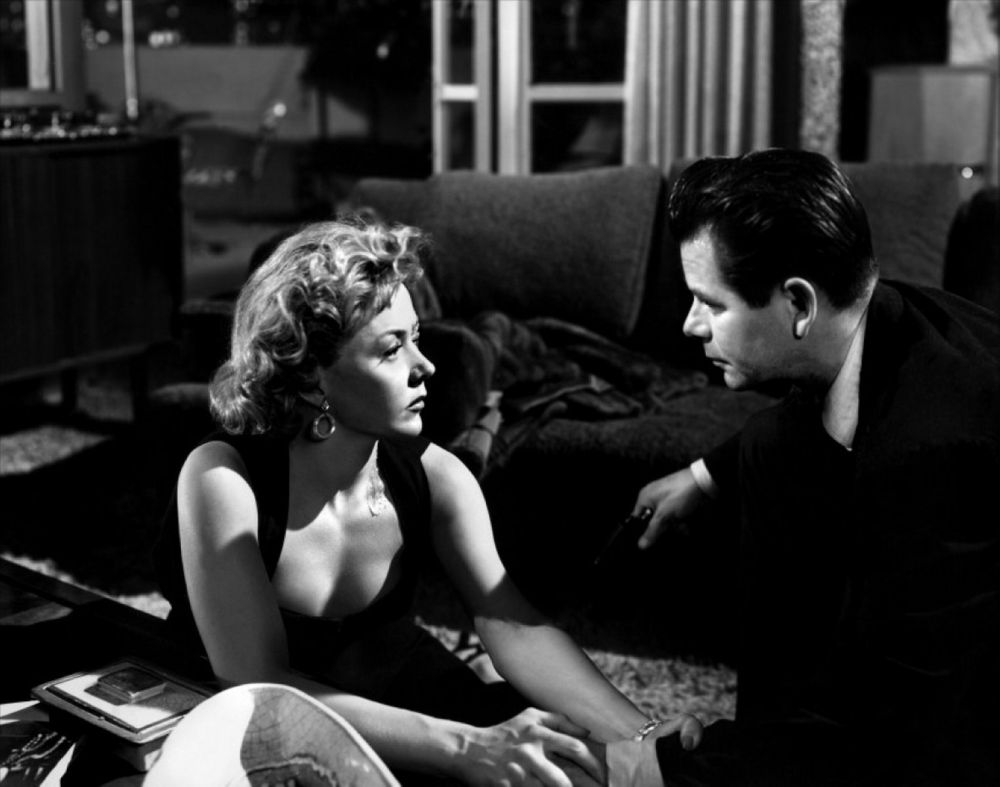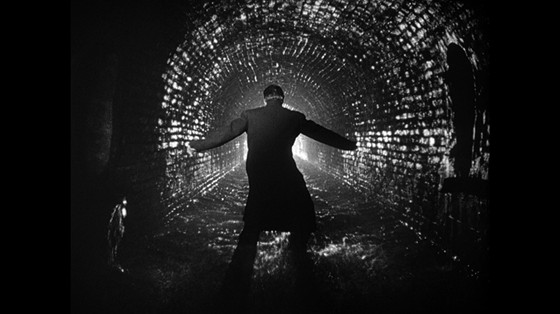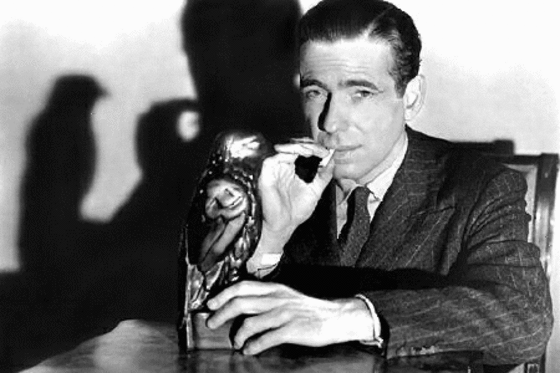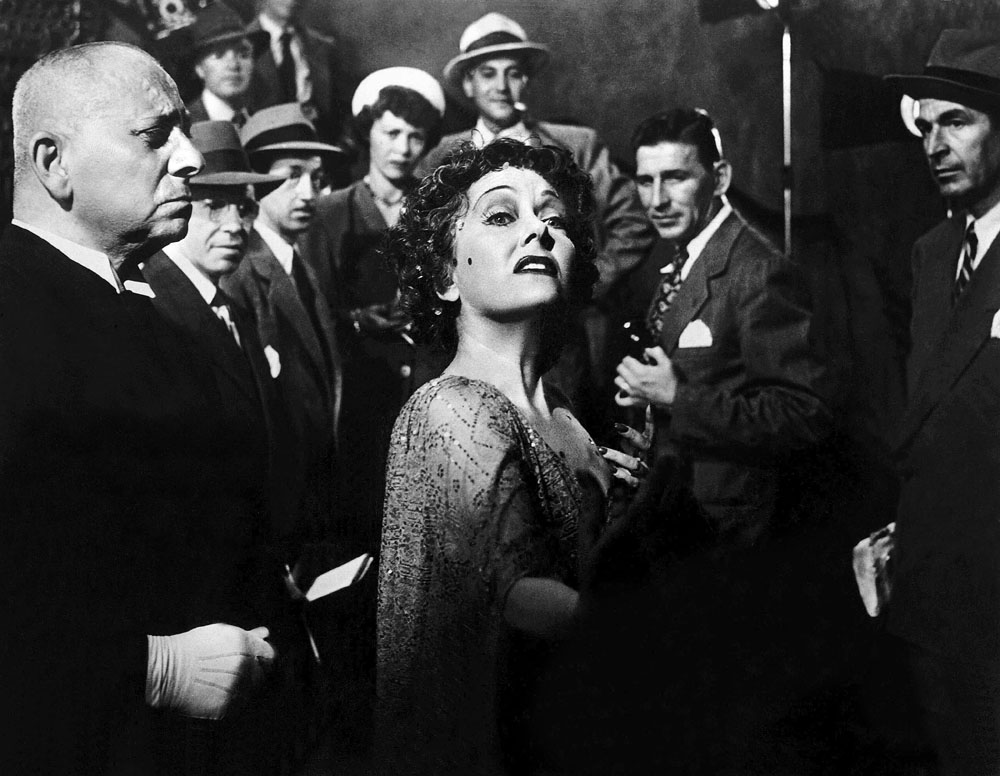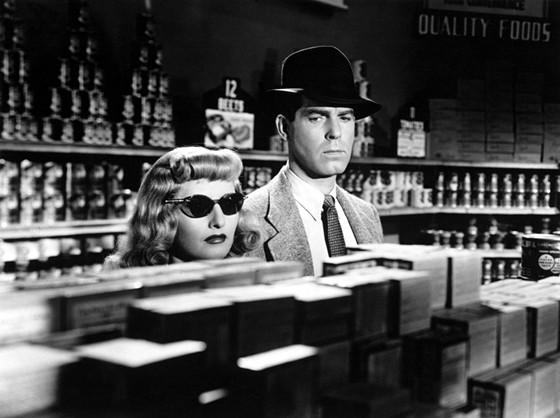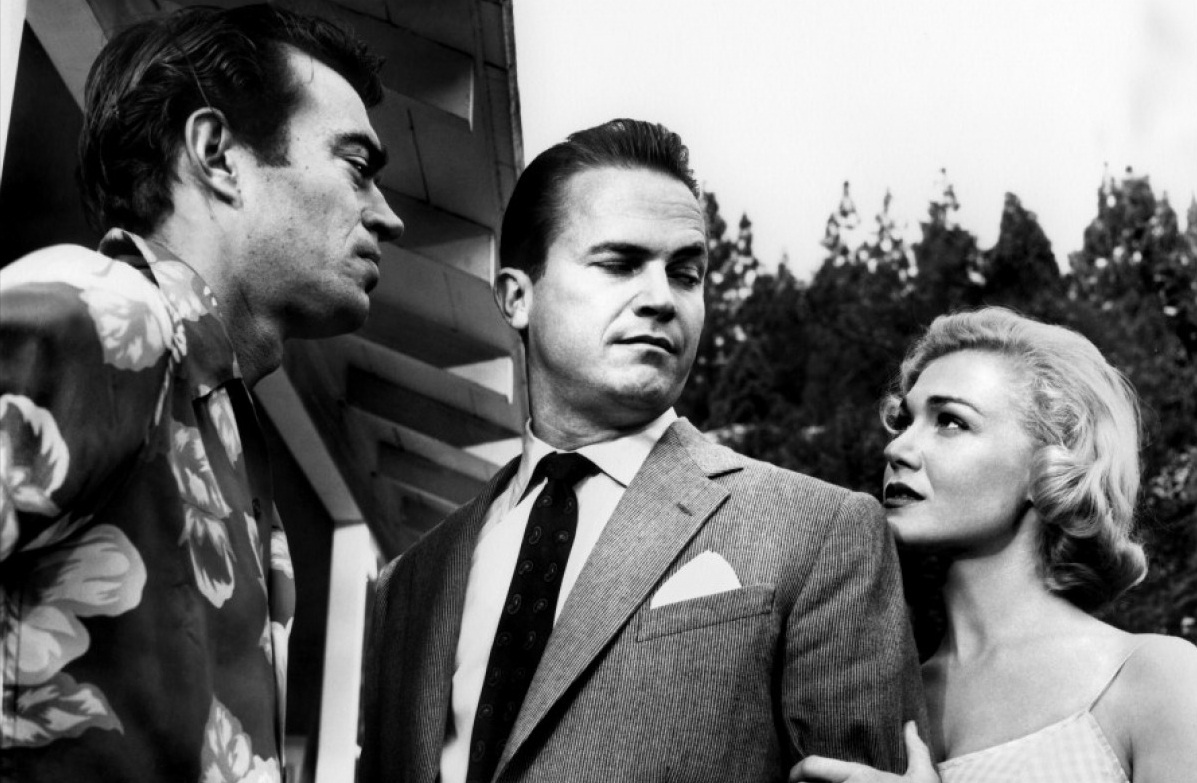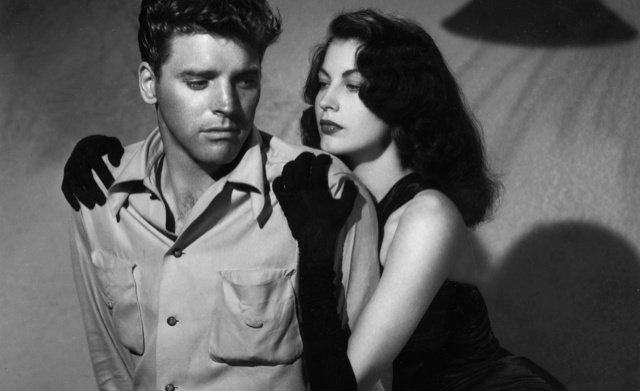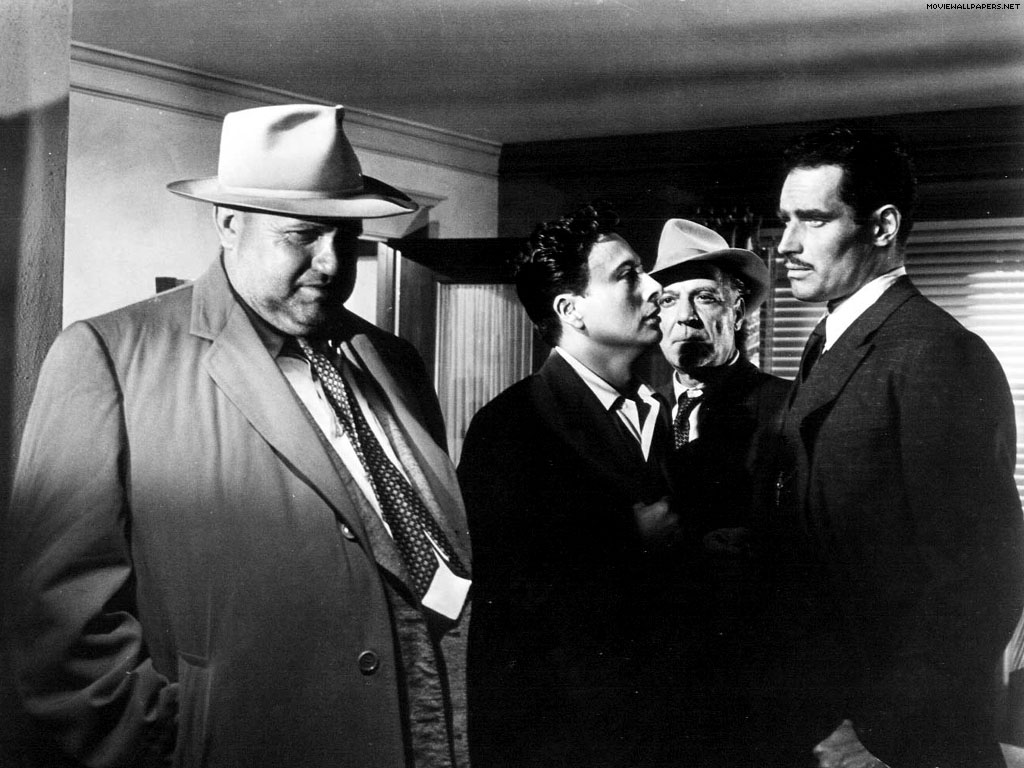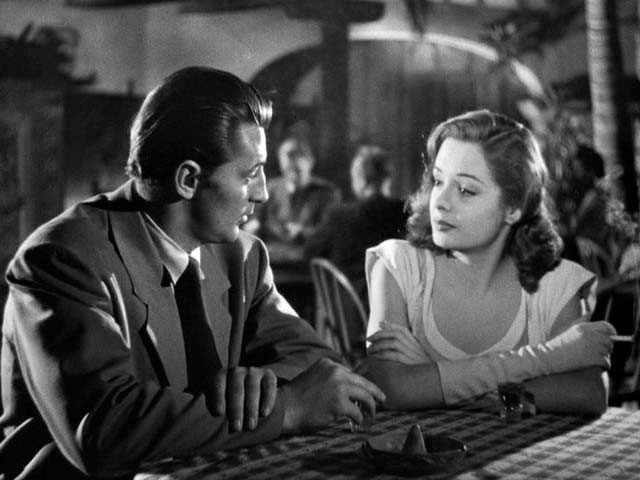10. D.O.A. (1950)
Released at the midpoint of the noir cycle, D.O.A. stars noir regular Edmund O’Brien as Frank Bigelow, as small town accountant who leaves his girlfriend Pamela and comes to San Francisco for a vacation. Frank meets some people and goes to a Fisherman’s Wharf nightclub for a night of wild jazz, where his drink is poisoned by a mysterious stranger.
The next day, Frank wakes up not feeling well and after going to a doctor he is told that he has swallowed a poison which will give him only a few days to live. The rest of the film involves Bigelow sorting out the reasons that someone wanted him poisoned and, in effect, solving his own murder.
As was more typical of the previous decade’s film noir, D.O.A. is told in voice over flashback, as Bigelow recounts the events that have led him to be ‘D.O.A.’ at the Los Angeles police station. Directed by former Cinematographer Rudolph Mate and featuring a cast of noir regulars including Pamela Britton, Beverly Garland and Neville Brand, D.O.A. has a unique storyline and was remade in 1988 with Dennis Quaid and Meg Ryan. My advice: see the original!
9. The Big Heat (1953)
A brutal and violent story of the clash between a gang of criminals and upright police detective Dave Bannion (Glenn Ford) is kicked off when fellow police officer Duncan commits ‘suicide’ under mysterious circumstances. Investigating the case, Bannion comes into contact with syndicate boss Lagana and his second-in-command Vince Stone (played by a menacing Lee Marvin, a dozen years or so before he attained film stardom).
When Bannion’s car is blown up and his wife killed, the policeman resigns the force and goes on a crusade for justice. Bannion stands up to Stone when he tries to bully a woman in a night club, and Stone’s girlfriend Debby Marsh (Gloria Grahame) speaks to Bannion on the street afterwards about her boyfriends nefarious activities.
For her efforts, she has a pot of hot coffee thrown in her face later by the vicious Stone. Disfigured, she helps Bannion bring down Stone and Lagana. Suffice it to say, The Big Heat is a tough, gritty crime film, directed with the usual style by noir regular Fritz Lang. A must see.
8. The Third Man (1949)
The Third Man is rare for being a non-American film that is now largely identified as a film noir. The Third Man follows the story of Holly Martins (Joseph Cotton), an American writer of cheap westerns who has come to seedy post-war Vienna at the behest of his longtime friend, Harry Lime (Orson Welles), only to find that Lime has apparently just been killed in a car accident on the street in front of his home.
He befriends the mysterious Anna Schmidt (Alida Valli), an actress and Lime’s girlfriend, and begins to investigate the suspicious and somewhat contradictory stories that surround his friend’s death, most notably the fact that a ‘third man’ was seen helping carry off the body after the crash.
Martin’s relentless pursuit of the truth eventually reveals that Lime was a ruthless black marketeer who has killed a man who was selling him stolen penicillin and has disappeared and had the man buried in his place when the scheme unravelled. Lime eventually reveals himself to Martins, emerging from the darkness of an alley in one of the most famous shots in film history.
The Third Man is memorable not only for its expressive, shadowy black and white cinematography, but also for its use of odd camera angles (somewhat reminiscent of Welles’ own films) and the innovative use of the unusual zither music on its soundtrack. Directed by Carol Reed, the film was a substantial hit at the time of its release and, due to its innovative stylistic devices,
The Third Man has seen its reputation grow in succeeding years. In 1999 the film was awarded with the honor of being named the “Best British Film of the 20th Century” by the British Film Institute, a testimony to the power and magnificent style of The Third Man.
7. The Maltese Falcon (1941)
Generally considered the film that started the genre (or cycle, if you prefer), The Maltese Falcon introduced Humphrey Bogart as a hard boiled leading man and also was the first film directed by John Huston, who would direct several later noir films.
Bogart is Dashiell Hammet’s Sam Spade, whose San Francisco detective agency Spade & Archer is visited by a Miss Wanderly, who turns out to be Brigid O’Shaughnessy (Mary Astor). She requests the detectives find a man named Floyd Thursby whom she says has run off with her younger sister but when Archer goes to tail Thursby he is shot dead.
Thursby is also killed later that same night, and Spade is pulled into a whirlwind of mystery and drama as the police suspect him of killing Archer, as Spade had earlier had an affair with his partner’s wife. Trying to get the truth out of Brigid is difficult, and eventually Joel Cairo (Peter Lorre) convinces Spade to help him find the priceless ‘Maltese Falcon’, which is being sought also by Kasper Gutman (Sidney Greenstreet) and his hired gun Wilmer (Elisha Cook, Jr.).
The Falcon is supposedly coming in on a ship and when the ship’s captain arrives with the Falcon at Spade’s office he is dying of a gunshot wound. In a final showdown, Spade must sort out whom to turn over to the police for the various murders and also, of course, who gets the Falcon.
As in many of Huston’s other films, particularly The Treasure of the Sierra Madre (1948), the film is all about a group of rogues seeking ill gotten gain, which none of them end up obtaining. Bogart was superb as Spade and he gets all the film’s good lines, including the classic finale when asked by the police what the Maltese Falcon statue is, he can only reply: “The, uh, stuff that dreams are made of!”
Produced at Warner Brothers, The Maltese Falcon was the first of many hard boiled detective films that dominated the box office in the 1940’s and was the beginning of a great run for Bogart as Hollywood’s top male star.
6. Sunset Boulevard (1950)
Billy Wilder essentially brought the first, ‘classic’ period of film noir to a close in 1950 with Sunset Boulevard, his story of a faded silent film star, Norma Desmond (Gloria Swanson) who takes in a struggling young screenwriter, Joe Gillis (William Holden).
Joe is to write Norma’s ‘comeback’ film, but merely ends up a gigolo and her kept man. He finally tries to break away from his keeper when young studio reader Betty Schaefer (Nancy Olson) takes an interest in a script that he has written and begins to meet him late at night to help him finish the story. But things go wrong when Norma becomes jealous, and Gillis cannot escape from the spider’s web in which he is enmeshed.
Finally, he ends up floating in the pool as the assorted media gather and the newsreel cameras roll for Norma’s great final scene: “I’m ready for my close up now, Mr. De Mille!” With former silent film director Erich Von Stroheim along as the creepy butler (and Norman’s ex-husband) Max, Sunset Boulevard has become an iconic film, the classic story of faded tinseltown in decline and the dangers along the way on the boulevard of broken dreams.
5. Double Indemnity (1944)
While The Maltese Falcon is considered the first and most groundbreaking film noir, Billy Wilder’s Double Indemnity, made three years later, established most of the conventions of the early ‘classic’ period. The ostensible ‘hero’ of the film is not an honorable man like Sam Spade; instead, it is Walter Neff (Fred MacMurray), an easy going life insurance salesman who falls into the trap set by Phyllis Dietrichson (Barbara Stanwyck) when he comes to talk to her about the renewal of her husband’s life insurance policy.
Phyllis convinces Walter to help her kill her unlikeable husband, then make it appear as if the man has fallen from the back of a train so that the grieving widow can get double indemnity on his life insurance policy because the death was by accident. Barton Keyes (Edward G. Robinson), Neff’s friend and insurance investigator immediately suspects foul play, but he doesn’t know that his friend and associate is a co-conspirator in the crime.
The story in Double Indemnity is told by Walter Neff in flashback, and this technique became a standard practice in most of the film noir to come over the next five years. The sense of doom, coincidence, entrapment and distrust that pervade Double Indemnity all quickly also became conventions of film noir. Based on a novel by hard boiled writer James M. Cain, Wilder broke away from his normal writing partner Charles Brackett to pen the screenplay for Double Indemnity with another hard boiled writer, Raymond Chandler.
The film was a huge hit, nominated for best picture Oscar and Wilder’s first best directing nomination and also Stanwyck for best actress. The score was by Miklos Rozsa, another European emigre who did the music for many film noir. Viewed today, Double Indemnity might seem a little corny, but that is only because the numerous conventions that it established have been so often used and overused in the years since; at the time of its release, the film was a groundbreaker.
4. Kiss Me, Deadly (1955)
Film noir was violent in the 1940’s, but became even more violent and brutal in the 1950’s as the production code slowly lifted. First and foremost of this new breed of protagonists was Mickey Spillane’s Mike Hammer, portrayed in this film by the brooding Ralph Meeker. One night driving on a dark road, Hammer picks up Christina (Cloris Leachman in an early appearance) hitchhiking wearing nothing but a trench coat.
When Christina is killed and Hammer ends up in a hospital, he begins a search to find out what the young woman – who had recently escaped from a mental institution – was so afraid of when Hammer encountered her. With the help of his trusty secretary Velda, Hammer finds Lily Carver (Gaby Rodgers), Christine’s roommate who is after, what she calls “the great whatsit”, a box that turns out to contain a dangerous, glowing substance that Lily thinks is worth a fortune.
The explosive end of the film reveals the truth about “the great whatsit” and the people who are after it, and indicated a new direction for noir films in which the growing paranoia about atomic and nuclear power would replace the genre’s former pre-occupations.
Kiss Me Deadly was shot quickly in and around Los Angeles by director Robert Aldrich, who would later make such classics as Whatever Happened to Baby Jane (1962) and The Longest Yard (1974). The film’s ending was changed and altered after its release, but the original ending has finally been restored and the film has been released properly on blu-ray.
3. The Killers (1946)
Released just after the end of World War II, the Killers has all the elements that made film noir what it was in its early incarnation. The first twenty minutes of the film are based directly on the Ernest Hemingway short story of the same name, taken from the series of Nick Adams stories that Hemingway wrote.
Two hit men arrive in a small town demanding to know the whereabouts of Ole Andreson (Burt Lancaster, in his first film role), known as “the Swede”. Nick Adams goes to warn the Swede that the killers are coming, but the Swede is resigned to his fate, saying “I got in wrong once” and he is executed by the killers in his bed. Andreson’s death is investigated by life insurance investigator Jim Reardon (Edmund O’Brien) and as Reardon interviews the Swede’s friends his story is told in flashback.
A boxer who had to retire from the ring due to an injury, the Swede falls in with a bad crowd including the beautiful Kitty Collins (Ava Garnder) and ‘Big Jim’ Colfax (Albert Dekker) and ends up taking a rap for Kitty and going to prison for three years. When he gets out, he again becomes involved with Kitty and Big Jim, who is planning payroll robbery.
Kitty warns the Swede that Big Jim is planning to double cross him and, after the heist, she and the Swede make off with the money and go to Atlantic City, but Kitty eventually disappears with the loot. Reardon ends up figuring it all out and solves the crime at a final showdown at Big Jim’s mansion.
Although the Swede and Reardon never appear together in the film at the same time, the investigator seems to identify with the troubled ex-boxer and takes on the solving of his case as a personal matter. Directed by German emigre Robert Siodmak, who also directed a number of other film noir after this, The Killers established Lancaster as a talent to be reckoned with, and put Ava Gardner on the map as the ultimate duplicitous femme fatale, Kitty Collins.
In the world of film noir, beautiful woman cannon be trusted, and a man who gives into to their charms quickly finds himself ensnared in a web of crime and deceit from which he cannot easily escape; even when he tries to run and hide, the past eventually catches up with him and so it is no surprise that the Swede gives in to his fate with a saddened resignation.
2. Touch of Evil (1958)
By the end of the 1950’s, film noir as a style had mostly petered out. When Universal hired star Charlton Heston to appear in a thriller with Janet Leigh and Orson Welles, Heston assumed that Welles would direct the film and insisted that Universal give him a chance.
With little time to prepare, Welles re-wrote the script based on the novel Badge of Evil and turned it into a memorable classic, featuring cameo appearances by Hollywood friends Marlene Dietrich, Zsa Zsa Gabor and Joseph Cotton. Heston is Miguel Vargas, honeymooning in a Mexican-American border town with wife Suzy (Leigh). He is on his way to Mexico City to testify against the drug lord Grandi, but is drawn into the investigation of the explosion death of an American contractor that he and Suzy witness.
The investigation is handled by police captain Hank Quinlan (Welles) and his faithful assistant Menzies (Joseph Calleia) who suspect the man was killed by Sanchez, a shoe clerk who was living with the murdered man’s daughter against his wishes. When sticks of dynamite are found in Sanchez’s apartment, Quinlan thinks he has his killer but Vargas thinks the evidence has been planted and sets out to reveal a pattern of police corruption on Quinlan’s part.
Quinlan eventually convinces Grandi’s brother, Uncle Joe (Akim Tamiroff) to kidnap Suzy and discredit Vargas by planting drugs on her. Touch of Evil features one of the most justifiably famous long shots in the history of film, the three plus minute opening shot in which the camera follows Vargas and Suzy walking near the car after a time bomb has been planted in it, until the bomb finally explodes.
Welles bold visual style was so potent and daring but was unconventional, and Universal reshot and reedited the film in the hopes of making it more commercial. After dying a quick death at the box office, the reputation of Touch of Evil grew over the years (as did almost all of Welles’ films) until the film was restored and re-released in 1998 with as much of Welles’ original vision as possible included.
Touch of Evil is a journey into a nightmare world of corruption, sin and evil, created by a visionary director and master filmmaker, and had a substantial influence on many films that came after it – particularly Hitchcock’s Psycho – but it also largely signaled the end of the era of the film noir. See it and see it as many times as you can.
1. Out of the Past (1947)
Taking up the theme of the inevitable failure of being able to outrun one’s past is the aptly named Out of the Past, made at RKO in 1947 and directed by Jacques Tourneur. Jeff Markham (Robert Mitchum) is, like the Swede, running from his past and living in a small California town as the proprietor of a gas station. When thug Joe Stefanos comes through the town he recognizes Markham and tells him that Whit Sterling (Kirk Douglas, in his second film role) wants to see him.
Jeff drives to Lake Tahoe to see Whit with his small town girlfriend, the pretty blonde Ann Miller, and tells her the story of his past in a flashback. He and his detective partner, Fisher, were hired by Whit to find Kathie Moffatt (Jane Greer) who has run off with $40,000 of Whit’s money.
Jeff goes to Acapulco to find the beautiful Kathie, but when he does she convinces him that she did not steal the money and Jeff falls in love with her; they evade Whit and Stefanos and head to San Francisco to begin a life together, only to eventually be confronted by Jeff’s old partner, Fisher, who wants to blackmail them. Kathie ends up shooting Fisher and runs away, leaving Jeff to clean up the crime. Now back in the present,
Jeff parts reluctantly with his girlfriend and meets with Whit, finding Kathie having returned also. Whit forces Jeff to go on another job for him to San Francisco to shake down Leonard Eels, an attorney who has some papers that can implicate Whit in a tax fraud scheme. Jeff tells his cabbie friend “I think I’m in a frame” as he goes to the apartment of Meta Carson (Rhonda Fleming), Eel’s secretary.
Eventually Jeff ends up back in Tahoe in a showdown with Whit and Kathie, having to make some ultimate choices between the blonde good girl (Ann) and the dark haired, sexy but deceitful femme fatale (Kathie). In true noir tradition, he makes the right choices, telling Kathie “Then you can build my gallows high…” but the results end up all wrong.
Mitchum is the ultimate noir hero, his tough guy persona and heavy eye lids drawn into a web of intrigue and dirty double crossing that he cannot escape from, even when he tries to hide in a small town. With its emphasis on fate and the impossibility of outrunning the past, with its oily bad guy, beautiful, dangerous femme fatale and fated, hard boiled protagonist, Out of the Past is one of the complete and ultimate film noir.
Author Bio: Jim Davidson is a 1980 graduate of Northwestern University’s Radio-TV-Film Dept. He lives in the San Francisco Bay Area and has been a video producer since 1987. Jim has written articles for Images Film journal and is currently working on a book about the movie Harold and Maude.
